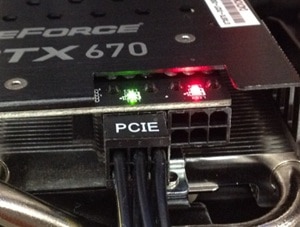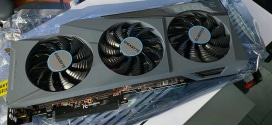ASUS has been one of Nvidia’s premier partners for a while, and for good reason. ASUS always has a special way of supercharging its GPU offerings and what we have here today is no different. The GTX680 DirectCU II will plant you in your seat as it jumps out of the gate. Now let’s look at what this card has to offer.
Introduction – ASUS GeForce GTX680 DirectCU II TOP
The ASUS way of handling GPU’s is quite unique. They often release excellent non-reference video cards as soon as AMD or Nvidia allows it. Quite some time ago we had the chance to look at a Matrix 580, and we were blown away by the sheer amount of engineering that went into the card. Add to this the fact that ASUS has a staff of overclockers on hand working with the R&D and Engineering teams. How can you not expect something really awesome to come from it? What we have today is the top model as of now for the GTX680 offering from ASUS the GeForce GTX680 DirectCU II TOP edition card.
TOP edition cards are basically ASUS speak for the top clocking top binned cards from the stack (with the exception of the rare Matrix models which we hear rumors of on the 680 model). A top binned card means you see some amazing speeds from it. Normally binning happens by the manufacturer placing a load of cards in to torture test and picking out ones that run that speed or “pass” that testing. This allows the manufacturer to find the limit of the card’s potential and set that as their top clocked model. This is called Edge binning which means when you get the overclock model card it is already at the razor’s edge of speed without the user having to mess around with voltages. ASUS TOP cards are not edge-overclocked, and in fact they test each card to ensure it has a certain amount of headroom over the stated speed so that power users still have some wiggle room for extra performance. The TOP moniker and performance is just an identifier to show what really is under the hood so to speak.
This card definitely is surprisingly not very bad price wise as it carries a full custom cooler, monster PCB and a monster clock along with it, all at a retail price of $539.99 on Newegg. This puts it well below contenders from MSI or EVGA and even Zotac. Normally, we would not call a card over 500 dollars a value product, but when compared to the competition presently listed at Newegg, we must say this looks like it could be one hell of a performance bargain.
Key Features
SAP (Super Allow Power)
ASUS has great pride in the components they infuse into their graphics offerings very much like the motherboards we have covered previously. ASUS has whats called SAP or Super Alloy Power which covers the components in the very VRM we are discussing. The components are hand picked for quality and performance based around not only power delivery but efficiency as well. The components in the SAP solution are super durable for a rated lifespan of up to 2.5X what reference cards would offer and also with the DIGI+ controller your talking ultimate precision which means better voltage stability, better overclcoking potential and overall better power efficiency clock for clock.
Here we see the VRM Chokes, Mosfet/driver Assemblies and the solid state caps which make up the SAP components or to simplify the super strong and efficient VRM.
Here we see what makes the difference for the DIGI+ solution which has to do with the accuracy and efficiency of the Digital controller in comparison to the analog VRM control we see on many other solutions. This level of control allows for unprecedented voltage accuracy, along with lower signal noise and overall more overclockability due to the tighter stability offered by the DIGI+ digital controller.
DCII (Direct CU II)
ASUS DirectCU II coolers are the ASUS way of saying maximum cooling and plenty of quiet with one naming scheme. DirectCU II coolers are direct touch heatpipes to the GPU surface ensuring the heat is wicked away from the GPU and up into the cooling fin array as quickly as possible. From there the custom shrouded dual fans push air through the fins effectively but most important quietly to keep the GPU as cool as possible so hopefully it will never hit a temp to need a higher or noisier fan speed. The air pushing through the fin array also helps cool board components and the VRM cooler as well which is a nice little added bonus to this style cooler since we all know cooler components tend to run stronger, longer and with better efficiency.
Dust proof Fan Technology
You would thing that by now everyone would know that one of the number one killers of a fan is the dirt and dust it comes into contact with. Many fans simply are not sealed in such a way that it can keep dust out and in many cases they are not sealed at all and you can see the sensitive winding area clearly exposed just by looking at the gap.
Here you can see that the ASUS solution is not just seaking the hub from dust but having 2 levels of sealing which means that over the lifespan of the cooler you can expect a much lower likelihood that you will get the grinding or simply the failing taht you normally get from the unprotected fan as seen above.
I cannot count how many times I have had a perfectly good card or cooler just to have it reduced to useless because the fan dies.
GPU Tweak
ASUS offers its own software utility and its functionality has grown with generations just like the cards it supports. Of course the card can be overclocked but also voltages can be tweaked and within the GPU Tweak app we can even launch the GPU info utility which is a full custom version of GPUz. This is a really cool feature and a benefit especially to benchmarkers who we can definitely see using this card with some of the awesome tweaks we will discuss in the card overview.
There are many tools within the GPU Tweak menus some a little more hidden than others. First off directly form the GPU Tweak utility itself you can check for BIOS updates and even update from within the program. For anyone whos ever updated a vBIOS before knows that having a tool that can do this in a mere few clicks is really handy.
The charts besides offering real time monitoring can also be setup to log thermals, voltages and clocks so that after benchmark or gaming runs you can see if there was any thermal issues or throttling that may have affected performance.
And another neat feature that many never delve into but its worth visiting is the custom fan profiling. This allos a specialized ramping of the fan according to a graph you set custom for your thermal/acoustic needs. Honestly after using this card awhile I would say the fan profile is damn near perfect as it keeps the card cool when under load and also super quiet when just messing around on the web.
The utility does come on the disk but its always advised to get the latest version HERE and search GPU Tweak in the ASUS page linked.
PCIe Power LEDs
One really cool feature is that there are status LED’s on each PCIe connector and these help you recognize that power is actively being sent to each connector of the card.
As seen above there is dual greens means your off to the races and everything is working well. However if the PCIe cable is not active or is not installed at all it will give you the red light which tells you something is wrong. I could definitely see some value in this when diagnosing multi card setups or even single card and getting just a black screen at post. a dead PCIe power cable could cause you to pull your hair out without these kinds of indicators and well I like my hair so I like these indicators
VGA Hotwire
ASUS is definitely known in the overclocking world for its products due to the simple fact that they overclock very well.
Speaking of special abilities, we have the VGA Hotwire. Anyone who knows about volt-modding a card knows it can cause serious damage. ASUS and their legion of overclockers knew this and made it possible to volt-mod the card with very little work needed and also with a compatible motherboard such as the Rampage IV Extreme a connector can be simply plugged onto the board to allow hardware level voltage manipulation. This is not some simple software control anymore. This is LN2-level modding. Also keep in mind that connecting and overvolting the cards to such extreme levels will likely void the warranty. Howeverr, overclocking with LN2 cooling at well over -100C which means you’ve pretty much thrown most chances of warrantying the card out the window anyways. We are very happy to see such features on a card as soldering to SMD’s that some times are little more than the size of a grain of salt can be very troublesome, and with so many densely packed components its far to easy to have an oops moment.
Here we see the reference of where each connection will be made. Do note that the connections on the card would need to be soldered which requires some soldering knowledge. The motherboard side is as simple as plugging onto the board.
GPU Boost
Nvidia implemented the GPU Boost feature on the new Nvidia GeForce 6 series GPU’s of the Kepler Architecture. This allows the card to have a base clock and it adjusts dynamically or overclocks to a speed of up to a certain amount depending upon the thermal and power envelope. This makes Overclocking these cards a bit different as you now are overclocking with a boost clock and by offsets from the out of the box clocks. We will discuss more of the overclocking aspects in the overclocking section but it does need to be noted. The voltage envelope can be adjusted as well with another offset setting. This will raise the ceiling in most cases for more overclocking headroom pending temps are within check which with this cooler should not be much of an issue.
Adaptive V-Sync
Nvidia also included another feature as of recent called “Adaptive V-Sync” which allows for better performance while also stutter free gameplay by actively enabling and disabling V-Sync depending upon gaming situation and FPS all without any intervention from the user.
PCI Express Gen 3 Capable
ASUS wants to ensure everyone is aware that PCIe 3.0 is here and ASUS is ready with not only cards such as this but boards to support it as well.
 Bjorn3D.com Bjorn3d.com – Satisfying Your Daily Tech Cravings Since 1996
Bjorn3D.com Bjorn3d.com – Satisfying Your Daily Tech Cravings Since 1996























